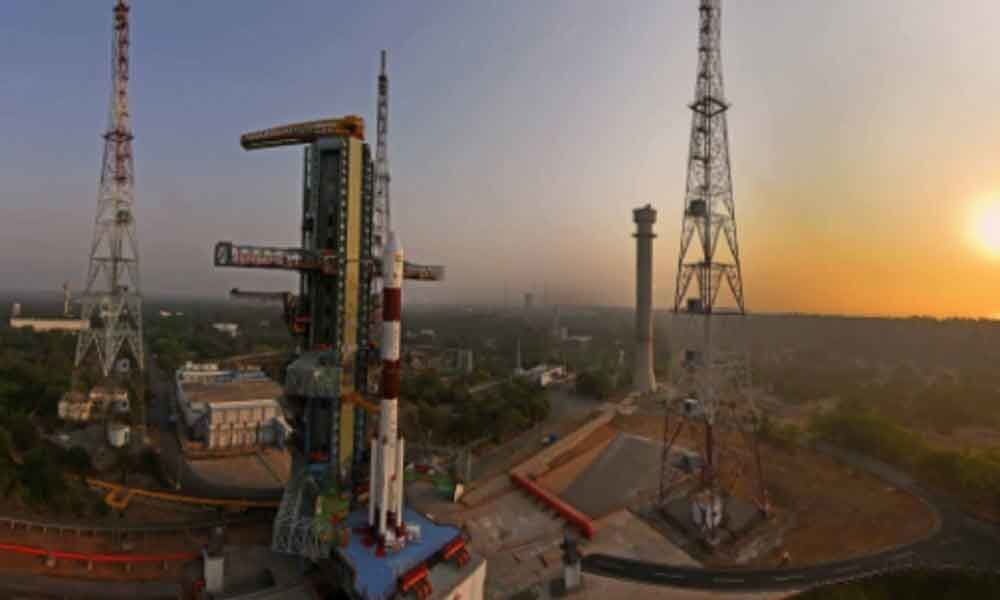Live
- Boxing Day Test Weather Forecast: Rain Delays Expected on Day 3 and Day 4 in Melbourne
- Baby John Twitter Reviews: Varun Dhawan Impresses, But Fans Feel the Remake Lacks Theri's Charm
- Pakistan Air Strikes Kill 46 in Afghanistan, Taliban Confirms Amid Rising Tensions
- ACB Launches Investigation into Formula E Races Held in Hyderabad Last Year
- Mega Job Mela in Madhapur on December 28: Explore Employment Opportunities in Hyderabad
- New Mizoram Guv likely to take charge next week
- Barroz 3D Movie Review: A Visual Treat for Mohanlal Fans, Mixed for Others
- Donate Blood, Save Lives: BJP Hosts Mega Blood Donation Camp in Aiza
- Azerbaijani Airliner Crashes Near Aktau, Kazakhstan: 32 Survive, Over 30 Feared Dead
- Union Minister Bandi Sanjay Kumar to Visit Jogulamba Gadwal District on December 27, 2024
Just In

The EMI ST satellite is aimed at electromagnetic measurement.
A 27-hour countdown began on March 31 for the launch of India's EMISAT satellite along with 28 nano satellites of global customers from Sriharikota Monday, a mission which would witness the ISRO placing payloads in three orbits and conducting space experiments for the first time.
The EMISAT satellite is aimed at electromagnetic measurement.
The countdown began at 6.27 am for the launch on board Indian Space Research Organisation's third generation workhorse Polar Satellite Launch Vehicle (PSLV), in its 47th flight, ISRO said.
The four-stage PSLV-C45 will blast off from the second launch pad at the spaceport of Sriharikota, about 125 kms, at 9.27 AM on April 1, agency officials said.
The mission will mark several firsts to the credit of the space agency as it would manoeuvre satellites in various orbits and orbital experiments including on maritime satellite applications.
According to ISRO, a new variant of the rocket PSLV-QL equipped with four Strap-On motors in the first stage is used for the launch.
PSLV, also used in India's two key missions -- "Chandrayan" in 2008 and Mars Orbiter in 2013, is a reliable and versatile launch vehicle for ISRO with 39 consecutive successful flights till June, 2017 and five-in-a row from January 2018.
The rocket has encountered only two failures so far -- its maiden developmental flight ended unsuccessful way back in 1993.
In September, 2017 the flight went off without any hitch but the IRNSS-1H Satellite could not be released into orbit after the PSLV-C39's heat shield failed to open on reaching the orbit.
In Monday's mission, ISRO scientists would place the satellites and payloads in three different orbits, a first for the agency. After injecting the 436 kg primary satellite EMISAT, intended for electromagnetic spectrum measurement, at around 17 minutes from lift off in a 749 km orbit, they would restart the fourth stage again.
During this initiative, all the other 28 customer satellites, totally weighing about 220 kgs, would be released by lowering the fourth state to around 504 kms orbit. Again, the fourth stage would be reignited and further lowered to 485 kms orbit to serve as an orbital platform for carrying out space borne experimentations for the first time in ISRO's history.
According to ISRO, this is the first time it has been envisaged to provide a micro-gravity environment for research organisations and academic institutes to perform experiments. The PS4-fourth stage hosts three payloads in this mission.
They are automatic identification system from ISRO for Maritime satellite applications capturing messages transmitted from ships.
Automatic Packet Repeating System from AMSAT (Radio Amateur Satellite Corporation), India to assist amateur radio operators in tracking and monitoring position data.
Advanced Retarding Potential Analyzer for lonospheric Studies (ARIS) from Indian Institute of Space Science and Technology (IIST) for the structural and composition studies of ionosphere.
The other 28 international satellites -- 25 3U type, two 6U type and one 2U type nano satellites -- are from Lithuania (two), Spain (1), Switzerland (1) and the United States (24). All these satellites are being launched under commercial arrangements, ISRO said.
The previous launches by ISRO this year include the imaging satellite Microsat-R for military purpose along with 1.2 kg Kalamsat in January onboard PSLV-C44.
In February, ISRO launched India's communication satellite GSAT-31 from the European launch service provider Ariane from French Guiana.PSLV-C45,ISRO,EMISAT satellite,Sriharikota

© 2024 Hyderabad Media House Limited/The Hans India. All rights reserved. Powered by hocalwire.com







